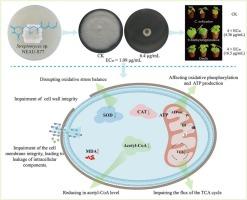9-Methylstreptimidone: A novel promising fungicide disrupting material metabolism and energy synthesis in Colletotrichum orbiculare
IF 4
1区 农林科学
Q2 BIOCHEMISTRY & MOLECULAR BIOLOGY
引用次数: 0
Abstract
Cucumber anthracnose caused by Colletotrichum orbiculare is one of the most critical diseases affecting cucurbit crops. Traditional chemical controls mitigate the disease but raise environmental and residue concerns, highlighting the need for eco-friendly alternatives. In this study, three glutarimide compounds were isolated from strain NEAU-S77, identified as a member of the genus Streptomyces, including the active compound 9-methylstreptimidone and two known analogs. 9-Methylstreptimidone exhibited strong antifungal activity against C. orbiculare, with an EC50 of 1.09 μg/mL, outperforming the commercial fungicide Duofu (EC50 = 4.12 μg/mL). Microscopic and biochemical analyses revealed that treatment with 9-methylstreptimidone caused abnormalities in mycelial and cellular structures, compromised cell wall integrity, and disrupted cellular redox equilibrium. Pot experiments showed higher control efficacy against cucumber anthracnose at 2 × and 4 × EC50 (76.9 % and 87.6 %) than Duofu (70.2 % and 80.0 %). Transcriptomic analysis revealed that 9-methylstreptimidone predominantly interfered with the citrate cycle, oxidative phosphorylation, and peroxisome biogenesis. These findings elucidate the antifungal mechanism of 9-methylstreptomycin and underscore its potential as a sustainable fungicidal agent for managing cucumber anthracnose.

9-甲基链米酮:一种有前景的新型杀菌剂,可破坏炭疽菌的物质代谢和能量合成
由圆形炭疽菌引起的黄瓜炭疽病是影响瓜类作物的主要病害之一。传统的化学控制措施减轻了这种疾病,但引起了对环境和残留的担忧,突出了对环保替代品的需求。本研究从链霉菌属菌株NEAU-S77中分离得到3个戊二酰亚胺化合物,包括活性化合物9-甲基streptimidone和2个已知类似物。9-甲基streptimi酮对圆锥虫的抑菌活性较强,EC50为1.09 μg/mL,优于市售杀菌剂多富(EC50 = 4.12 μg/mL)。显微镜和生化分析显示,用9-甲基streptimi酮治疗会导致菌丝和细胞结构异常,破坏细胞壁完整性,破坏细胞氧化还原平衡。盆栽试验结果表明,2倍和4倍EC50对黄瓜炭疽病的防治效果分别为76.9%和87.6%,高于多复(70.2%和80.0%)。转录组学分析显示,9-甲基streptimidone主要干扰柠檬酸循环、氧化磷酸化和过氧化物酶体的生物发生。这些发现阐明了9-甲基链霉素的抗真菌机制,并强调了其作为一种可持续的黄瓜炭疽病杀菌剂的潜力。
本文章由计算机程序翻译,如有差异,请以英文原文为准。
求助全文
约1分钟内获得全文
求助全文
来源期刊
CiteScore
7.00
自引率
8.50%
发文量
238
审稿时长
4.2 months
期刊介绍:
Pesticide Biochemistry and Physiology publishes original scientific articles pertaining to the mode of action of plant protection agents such as insecticides, fungicides, herbicides, and similar compounds, including nonlethal pest control agents, biosynthesis of pheromones, hormones, and plant resistance agents. Manuscripts may include a biochemical, physiological, or molecular study for an understanding of comparative toxicology or selective toxicity of both target and nontarget organisms. Particular interest will be given to studies on the molecular biology of pest control, toxicology, and pesticide resistance.
Research Areas Emphasized Include the Biochemistry and Physiology of:
• Comparative toxicity
• Mode of action
• Pathophysiology
• Plant growth regulators
• Resistance
• Other effects of pesticides on both parasites and hosts.

 求助内容:
求助内容: 应助结果提醒方式:
应助结果提醒方式:


